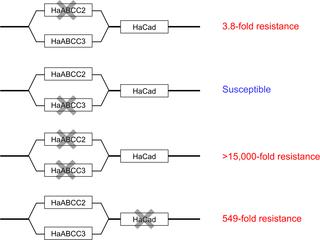PLoS Pathogens ( IF 5.5 ) Pub Date : 2020-03-19 , DOI: 10.1371/journal.ppat.1008427 Jing Wang 1 , Huanhuan Ma 1 , Shan Zhao 1 , Jianlei Huang 1 , Yihua Yang 1 , Bruce E Tabashnik 2 , Yidong Wu 1

|
Evolution of pest resistance reduces the efficacy of insecticidal proteins from the gram-positive bacterium Bacillus thuringiensis (Bt) used widely in sprays and transgenic crops. Better understanding of the genetic basis of resistance is needed to more effectively monitor, manage, and counter pest resistance to Bt toxins. Here we used CRISPR/Cas9 gene editing to clarify the genetics of Bt resistance and the associated effects on susceptibility to other microbial insecticides in one of the world’s most damaging pests, the cotton bollworm (Helicoverpa armigera). We discovered that CRISPR-mediated knockouts of ATP-binding cassette (ABC) transporter genes HaABCC2 and HaABCC3 together caused >15,000-fold resistance to Bt toxin Cry1Ac, whereas knocking out either HaABCC2 or HaABCC3 alone had little or no effect. Inheritance of resistance was autosomal and recessive. Bioassays of progeny from interstrain crosses revealed that one wild type allele of either HaABCC2 or HaABCC3 is sufficient to sustain substantial susceptibility to Cry1Ac. In contrast with previous results, susceptibility to two insecticides derived from bacteria other than Bt (abamectin and spinetoram), was not affected by knocking out HaABCC2, HaABCC3, or both. The results here provide the first evidence that either HaABCC2 or HaABCC3 protein is sufficient to confer substantial susceptibility to Cry1Ac. The functional redundancy of these two proteins in toxicity of Cry1Ac to H. armigera is expected to reduce the likelihood of field-evolved resistance relative to disruption of a toxic process where mutations affecting a single protein can confer resistance.
中文翻译:

两种 ABC 转运蛋白介导苏云金芽孢杆菌对棉铃虫毒性的功能冗余。
害虫抗性的进化降低了广泛用于喷雾剂和转基因作物的革兰氏阳性细菌苏云金芽孢杆菌(Bt)的杀虫蛋白的功效。需要更好地了解抗性的遗传基础,以便更有效地监测、管理和对抗害虫对 Bt 毒素的抗性。在这里,我们使用 CRISPR/Cas9 基因编辑来阐明 Bt 抗性的遗传学以及对世界上最具破坏性的害虫之一棉铃虫 ( Helicoverpa armigera ) 的其他微生物杀虫剂敏感性的相关影响。我们发现,CRISPR 介导的 ATP 结合盒 (ABC) 转运蛋白基因HaABCC2和HaABCC3的敲除共同导致了对 Bt 毒素 Cry1Ac >15,000 倍的抗性,而单独敲除HaABCC2或HaABCC3几乎没有效果或没有效果。耐药性的遗传是常染色体隐性遗传。对品系间杂交后代的生物测定表明, HaABCC2或HaABCC3的一个野生型等位基因足以维持对 Cry1Ac 的显着敏感性。与之前的结果相反,敲除HaABCC2 、 HaABCC3或两者都不会影响对 Bt 以外的细菌衍生的两种杀虫剂(阿维菌素和乙基多杀菌素)的敏感性。这里的结果提供了第一个证据,证明 HaABCC2 或 HaABCC3 蛋白足以赋予对 Cry1Ac 的显着易感性。 Cry1Ac 对H的毒性中这两种蛋白的功能冗余。 与破坏毒性过程相比,棉铃虫有望降低现场进化耐药性的可能性,在毒性过程中,影响单个蛋白质的突变可以赋予耐药性。











































 京公网安备 11010802027423号
京公网安备 11010802027423号